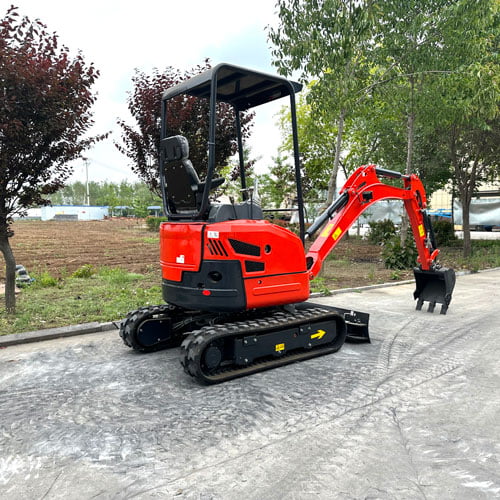Introduction
Mini excavators are invaluable assets on job sites, offering versatility and efficiency in various tasks. Their compact size and maneuverability allow them to excel in tight spaces where larger equipment might struggle. In this guide, we’ll explore how to maximize the uses of mini excavators on job sites, ensuring you get the most out of this powerful tool.
Understanding Mini Excavator Uses

Versatility on Different Job Sites
Mini excavators are known for their adaptability. Whether you’re working in landscaping, construction, or utility projects, these machines can handle a wide range of tasks. From digging trenches and clearing debris to lifting materials and performing demolition work, their versatility is unmatched.
Comparing Mini Excavator Models
To get the best performance, it’s essential to choose the right mini excavator model for your specific needs. Here’s a comparison table of popular mini excavator models, including a notable brand, Qilu, known for its robust equipment.
| Model | Operating Weight | Max Dig Depth | Engine Power | Notable Features |
|---|---|---|---|---|
| Qilu QLN-PRO 3.5 | 3,500kg | 2.8 m | 30 kW | High durability, efficient fuel use |
| Cat 303.5E | 3,000 kg | 3.3 m | 31 kW | Compact design, excellent stability |
| Kubota U35 | 3,500 kg | 3.4 m | 33 kW | Advanced hydraulics, smooth operation |
| Bobcat E35 | 3,600 kg | 3.5 m | 34 kW | Versatile attachments, robust performance |
Key Features to Maximize Mini Excavator Uses
Attachments and Accessories
Mini excavators can be equipped with various attachments to enhance their functionality. Some essential attachments include:
- Buckets: For digging and scooping.
- Hydraulic Breakers: For demolition tasks.
- Augers: For drilling holes.
- Grapples: For handling and moving materials.
Choosing the right attachment for your specific task can significantly increase the efficiency and effectiveness of your mini excavator.
Regular Maintenance
Proper maintenance is crucial for keeping your mini excavator in top condition. Regular checks and servicing can prevent breakdowns and ensure optimal performance. Key maintenance practices include:
- Checking fluid levels: Ensure hydraulic fluid, engine oil, and coolant are at proper levels.
- Inspecting filters: Replace air and fuel filters as needed.
- Lubricating moving parts: Regularly grease joints and other moving components.
Operator Training
A well-trained operator can make a significant difference in how effectively a mini excavator is used on site. Proper training ensures that the operator can handle the equipment safely and efficiently, reducing the risk of accidents and increasing productivity.
Practical Applications of Mini Excavators

Landscaping and Gardening
Mini excavators are excellent for landscaping projects. They can be used for tasks such as:
- Digging holes for plants and trees: The compact size allows for precision work.
- Clearing land: Removing shrubs, roots, and small trees.
- Grading and leveling: Preparing soil for planting.
Construction Projects
In construction, mini excavators can be employed for:
- Excavating foundations: Preparing sites for new structures.
- Trenching: For utility lines and drainage systems.
- Material handling: Moving and placing construction materials.
Utility Work
Utility work often involves working in confined spaces, making mini excavators ideal. Uses include:
- Installing and repairing pipelines: The compact size allows for access to tight areas.
- Trenching for electrical cables: Digging narrow trenches with precision.
- Clearing and maintaining access routes: Ensuring pathways are clear for utility work.
Conclusion:Mini Excavator Uses
Maximizing the use of mini excavators on job sites requires understanding their capabilities, selecting the right attachments, performing regular maintenance, and ensuring proper operator training. By leveraging these strategies, you can enhance productivity and efficiency, making the most of this versatile piece of equipment.
FAQ
What tasks can a mini excavator handle?
Mini excavators are capable of a variety of tasks, including digging, trenching, material handling, demolition, and landscaping. Their versatility makes them suitable for many different job sites.
How do I choose the right mini excavator model?
Choosing the right model depends on factors such as operating weight, dig depth, engine power, and specific job requirements. Reviewing different models and their features can help you select the best option for your needs.
What maintenance does a mini excavator require?
Regular maintenance includes checking and topping up fluid levels, inspecting and replacing filters, and lubricating moving parts. Regular servicing by a qualified technician is also recommended to keep the equipment in optimal condition.
How can attachments improve mini excavator performance?
Attachments allow mini excavators to perform a wide range of tasks beyond basic digging. By selecting appropriate attachments, you can enhance the machine’s functionality and efficiency for specific job requirements.
What safety measures should be taken when operating a mini excavator?
Ensure that operators are trained and certified, follow safety guidelines, and conduct pre-operation inspections. Using the equipment within its operational limits and wearing appropriate personal protective equipment (PPE) are also crucial for safe operation.




